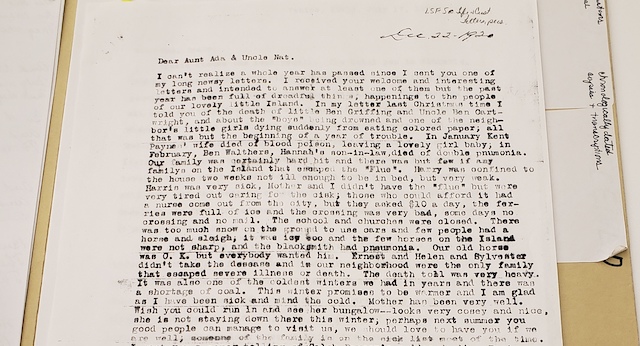
A letter from a past pandemic in the archives of the Shelter Island Historical Society gives of glimpse of what happened here during the Spanish Flu, which began in 1918 and lasted through 1920.
Dated December 22, 1920, the letter is signed “Eva”. It appears to be from Eva Benjamin Hudson, who according to U.S. Census records lived on the Island with her husband, David Harries Young; their son, David Harries Young Jr., and her mother, Sarah Cartwright Hudson.
David Harries Young, who is referred to in the letter as Harry, ran a general store, the Census says, and had been Shelter Island Town supervisor.
Letter from a past pandemic
Here is the pertinent section of the text:
Dear Aunt Ada and Uncle Nat,
I can’t realize a whole year has passed since I sent you one of my long newsy letters. I received your welcome and interesting letters and intended to answer at least one of them but the past year has been full of dreadful things, happenings to the people of our lovely little Island.
In my letter last Christimas time I told you of the death of little Ben Griffing and Uncle Ben Cartwright and about the ‘boys’ being drowned and one of the neighbor’s little girls dying suddenly from eating colored paper; all that was but the beginning of a year of trouble.
In January, Kent Payne’s wife died of blood poison, leaving a lovely little girl baby; in February Ben Walthers, Hannah’s son-in-law, died of double pneumonia. Our family was certainly hard hit and there was but few if any families on the Island that escaped the ‘Flue’.
Harry was confined to the house two weeks not ill enough to be in bed, but very weak. Harris was very sick, Mother and I didn’t have the ‘flue’ but were very tired out caring for the sick. Those who could afford it had a nurse come out of the city, but they asked $10 a day, the ferries were full of ice and the crossing was very bad, somedays no crossing and no mail.
The school and churches were closed. There was too much snow on the ground to use cars and few people had a horse and sleigh; it was icy too and the few horses on the Island were not sharp, and the blacksmith had pneumonia.
Our old horse was OK, but everybody wanted him. Ernest and Helen and Sylvester didn’t take the disease and in our neighborhood were the only family that escaped severe illness or death. The death toll was very heavy.
It was also one of the coldest winters we had in years and there was a shortage of coal. This winter promises to be warmer and I am glad as I have been sick and mind the cold. Mother has been very well.
Wish you could run in and see her bungalow — looks very cosey and nice, and she is not staying down there this winter; perhaps next summer you good people can manage to visit us. We should love to have you if we are well; someone of the family is on the sick list most of the time …
with love, Eva
More about Eva and David H. Young
While the letter itself did not include her surname, a review of Census and other historical records indicates that the letter writer likely was Eva Benjamin Hudson.
Hudson, a lifelong resident of Shelter Island, was reported to be the oldest person in residence here when she died in 1959 at age 91.
Her husband, David Harries Young — who at the time of her letter ran a general store — was the subject of a controversy relating to a family inheritance.
The story was recalled by local historians Patricia and Ed Shillingburg at their shelter-island.org website.
In 1888, a judge ordered that his maternal grandfather and long-time guardian, the Rev. Thomas Harries, pastor of the Presbyterian Church, pay Young a sum of $3,974.76, including funds that had been left to him as a boy when his parents died.
Follow this link to find the Shillingburgs’ account of the David Harries Young inheritance.
About the Shelter Island Historical Society
The Shelter Island Historical Society, founded in the 1920s and revived in the 1960s, “interprets Shelter Island’s past through historical material and through its people, from the first Native American inhabitants, settlers and town fathers, to those who have made it a caring and unique community through the years.”
“The Society strives to preserve the Island’s heritage for future generations.”
Located at 16 South Ferry Road, the Shelter Island History Center includes an archive of historical documents and artifacts, alongside the restored Havens House and Havens Barn. Due to concerns about the spread of the novel coronavirus, the center is temporarily closed to the public.
Learn more at shetlerislandhistorical.org.
Editor’s note: My colleague Julie O’Neill-Bliss and I spent a couple of hours last week looking through the archives before the center was closed to the public. We’ll share more in the coming days. We’re grateful to the staff for helping us find information about how Islanders dealt with past emergencies. Thanks particularly to Nanette Lawrenson, Alexandra Binder, Moriah Moore and Yvonne Purcell. If you have a story to share about how the Island responded to past emergencies, sent it to me at editor@shelterislandgazette.com. Thanks and stay well — Julia Brennan




